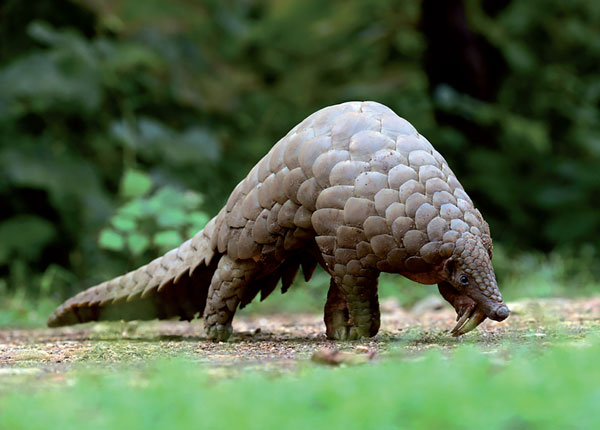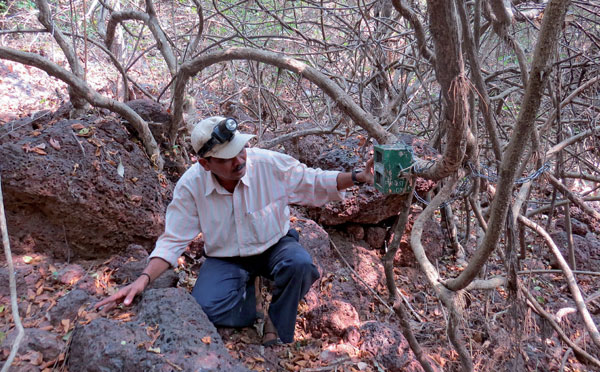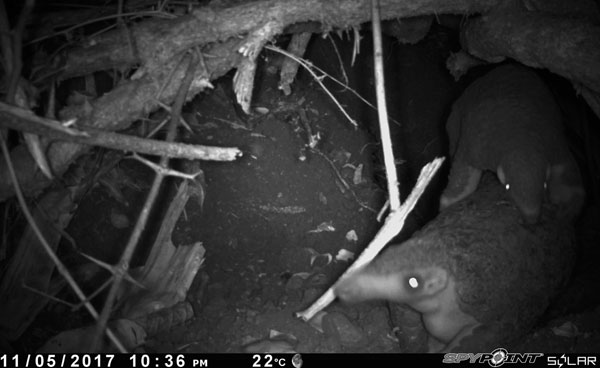Pangolins in Peril
First published in Sanctuary Asia,
Vol. 40
No. 4,
April 2020
by Zubin Unwalla and Abhishek Singh

Pangolins are shy, reclusive and gentle animals, spending most of the day in tree hollows or underground burrows, and venturing out only to eat at night. Widely hunted for the wildlife trade, their major mode of difference -- curling up into a ball of armour -- is sadly, ineffective against man's greed.
Photo courtesy: Alfred Weidinger
As night envelops India’s Konkan coast, its tree-canopied hills transmogrify into a vibrant, alternative universe. With the setting sun, its daytime inhabitants slip into slumber, making way for a mélange of interesting creatures that will rule the nocturne. From behind the trunk of a withered, old kinjal tree, a short snout pokes out vigilantly. It sniffs the silent night air for a few seconds before its owner steps out into plain view. This nocturnal denizen is one of the most bizarre creatures to roam the forest floor. Looking like a chimerical hybrid, its most striking feature is the arrangement of rust-tinted scales that cover its body. This armoured forager is a pangolin – reticent, elusive and rare, its existence is not known by many. Ironically, it is the world's most trafficked mammal, its numbers having been driven down to such alarming levels that it might go extinct before most people realise that this erent species of armadillo doppelgängers once inhabited our planet.
Dissecting the Pecularity
Eight species of the pangolin exist – the IUCN statuses of all eight range from ‘Vulnerable’ to ‘Critically Endangered’. The most threatened of them are the Asian species – the Chinese pangolin Manis pentadactyla, the Indian pangolin Manis crassicaudata, the Sunda pangolin Manis javanica and the Philippine pangolin Manis culionensis. The largest, the giant ground pangolin Smutsia gigantea, and the smallest, the black-bellied pangolin Phataginus tetradactyla, along with the whitebellied pangolin Phataginus tricuspis and Temminck’s ground pangolin Smutsia temminckii constitute the four African species.
Pangolins are insectivores, feasting on more than 20,000 insects, predominantly ants and termites, each day. Aptly called scaly anteaters, they possess one of the most bizarre tongue types in the animal kingdom. A pangolin’s tongue is muscular and sticky and is anchored at the base of its sternum. When fully distended, it can reach over 40 cm. – longer than the animal itself. This powerful tool helps it probe deep inside insects’ nests to find its prey. The pangolin, however, is quite fastidious about its diet – there are fewer than 20 ant and termite species that they prefer to devour! Along with insects, they swallow stones and sand. These help the toothless animals grind their meals, much like what happens inside a bird's gizzard.
Perhaps the most peculiar feature of the pangolin is the armour of keratinous scales that covers the dorsal part of its body from head to tail. These constitute close to a fifth of its body weight and act as one of the most effective natural defence mechanisms seen in the animal kingdom. When threatened, a pangolin curls itself up into a ball (the word 'pangolin' comes from the Malay word 'penggulung', which means “one that rolls up”) exposing only its tough scales. This has proven effective even against the dangerous swipes of lions and tigers. Moreover, it possesses special glands near the anus, which secrete a malodorous fluid to keep predators at bay. Well-adapted as it is to survive in the wild, it is unfortunate that neither its shield-like scales nor its rapier-like tongue have protected the pangolin against the most vicious species to have ever roamed our planet – man!

A pangolin forages the ground in the buffer zone of the Tadoba-Andhari Tiger Reserve, Maharashtra. Two species are found in India – the Chinese pangolin Manis pentadactyla and the Indian pangolin Manis crassicaudata.
Photo courtesy: Kamlesh Thakur
On the Brink of Doom
Fueled by superstition, misinformation and a penchant for perverse profligacy, a thriving market for trafficked pangolins has succeeded in driving this animal to near extinction. The pangolin’s scales are falsely touted to be something of a panacea in traditional Chinese medicine, a claim as scientifically unproven as that of the magical curative powers of the rhino’s horn. From assertions of exorcising demons to curing palsy, shamans and pseudoscientists have created an insatiable demand for this animal’s scales – causing the pangolin’s numbers to plummet. Moreover, pangolin bushmeat is considered a delicacy in the most opulent circles of China and Vietnam.
Recently, 12.7 tonnes and 14 tonnes of pangolin scales were seized in Singapore and Hong Kong respectively. This is, by no means, a one-off haul. In 2017, authorities seized 11.9 tonnes of pangolin scales from the port of Shenzen in China. This likely came from over 30,000 pangolins. Pangolin poaching incidents in India may not be as dramatic, but are deï¬nitely alarming. In 2016, 123 kg. of pangolin scales were recovered from a Burmese national in Mizoram, India. In 2018, officials apprehended a gang of seven, who were smuggling a pangolin in a car across Eastern India.
The Konkan coast is a hot-bed for pangolin poaching. In 2015, 44 kg. of pangolin scales were seized near Chiplun, while another stash of 12 kg. was recovered in Dapoli. In 2016, 750 g. of pangolin scales were seized when a house in Maharashtra’s Raigad district was raided. In 2017, the Maharashtra police managed to capture three men in possession of a live pangolin. They were apprehended in Sindhudurg, and were on their way to sell the hapless animal at a bargain. In March 2019, the Panvel range forest mobile squad acted on a tip-off and nabbed seven men off the Mumbai-Pune Expressway, attempting to smuggle a dead pangolin inside a gunny bag.
A Ray of Hope
Based in Chiplun, amidst the hills of the Konkan, the Sahyadri Nisarga Mitra (SNM) has been engaged in nature conservation through education and community participation since 1992. Besides indigenous turtles, birds and small mammals, the NGO has actively been involved in raising awareness and mobilising the local masses to conserve the pangolin.
Under the stewardship of Bhau (Vishwas) Katdare (Sanctuary Asia, Vol. 36, No. 10, October 2016), SNM has pushed the cause of nature conservation. Some of the NGO’s most successful projects include timely action to arrest smugglers of nests of the Indian Swiftlet in Vengurla Rocks, and an initiative to protect olive Ridley turtles along 720 km. of the Konkan coastline. Bhau Katdare is also a member the IUCN SSC Pangolin Specialist Group (2017-2020).

Composed of the same keratinous protein found in human nails, pangolin scales are falsely touted to have magical medicinal powers, and are a staple in Chinese traditional medicine to stimulate maternal lactation and treat skin diseases. Curbing this excessive, and illogical, demand is key to protecting the species.
Photo courtesy: Kenneth C
On a Mission to Save the World's Most Trafficked Mammal
Two incidents that resulted in the confiscation of a total of 56 kg. of pangolin scales in the Konkan, triggered SNM’s resolve to work towards the protection of this endangered mammal. From 2016, SNM began actively being involved in the insitu conservation of the pangolin in the Konkan, with the Forest Department, via field surveys, education, awareness workshops and mobilisation of the nearby townsfolk.
So, how do you chalk out a conservation strategy for a species so timorous that even in regions where it is densely populated, sightings are a rarity? The answer lies in a stealthtechnology based technique – motion sensor triggered camera traps that surreptitiously record an animal’s activity in its natural habitat.
SNM adopted camera-trapping to study indigenous pangolin populations in the Konkan, an ingenious method that resolves several snags at once. It surpasses the limitations of traditional survey and data-gathering methodologies, which require abundant manpower and time. In fact, it obviates human intervention completely, which is advantageous when studying a species as shy as the pangolin, across habitats, and over extended periods of time.
Since 2016, 15 Cuddleback and Spypoint trail cameras have been set up in various districts in the Konkan to document the presence and activity of the Indian pangolin. It is a testimony to the rarity and wariness of this animal that of the initial 600 camera days, only three recorded pangolin activities – a hit-rate of 0.5 per cent. However, gradually more than 40 cameras were deployed at identified pangolin burrows. In March 2019, SNM crossed 10,000 camera days, collecting 206 photographs and 90 videos of the pangolin in its natural habitat. These records prove to be a critical source in understanding the feeding habits of the Indian pangolin and the characteristics of its habitat.
Scat analysis was also used for covert observation of the pangolin’s feeding patterns. Samples of droppings were collected from various locations, and dried and stored for identification. With the help of Dr. Himender Bharti, an ant expert, the scat samples were profiled to determine the dietary preferences (ants and termites) of the Indian pangolin.


Since 2016, the Sahyadri Nisarga Mitra has deployed around 40 camera traps in the Raigad, Ratnagiri and Sindhudurg region. Camera trap photos and videos, as well as scat sample analyses, provide the critical resources necessary to analyse pangolin populations in the region, their behaviour and dietary preferences (they are known to be picky eaters), which will further enable the drafting of effective conservation strategies.
Photo courtesy: Sahyadri Nisarga Mitra
People Power
A vital ï¬rst step of conservation is to create awareness. And one cannot emphasise this enough for a species as elusive and lesser-known as the pangolin. Several activities are being conducted in the villages adjoining pangolin habitats. Incidentally, in 20182019, twelve pangolins were rescued when the local community informed SNM and the Forest Department. The animals were released back into their natural habitat in the wild.
Last mile penetration is achieved by gathering villagers for regular workshops, with considerable support from the Forest and Police Departments. In 2017 alone, over 200 locals from 135 villages participated. The workshops act as a medium to educate commoners about the existence and habits of the Indian pangolin, sensitise them towards its grave status, and chalk out district-level protection strategies. The workshops also serve to keep a check on the illicit trade of pangolin scales. Until now, 955 villages and 2,758 schools in the Ratnagiri district have been reached.
For widespread communication, the NGO uses Akashwani, the All India Radio, to highlight pangolin conservation. It also designed and released the Khawlu (Indian pangolin) mascot to raise awareness both nationally and globally. SNM also collaborated with cinematographer Ajinkya Khadpekar to create a documentary about the species in the local language. Banners and billboards with pictorial information about pangolins are also set up in the villages. SNM is also particularly focused on reaching out to young adults. Through activities like drawing competitions, essay-writing contests, it engages children and educates them about the Indian pangolin. SNM also published and released a pictorial story book about the Indian pangolin, written by Bhau Katdare in the local language. This story was introduced as a chapter in the middle-school syllabus and has since reached 1.6 million students – a number expected to be replicated annually!
In late February every year, wildlife enthusiasts and conservation bodies around the globe come together, united by a common cause – pangolin conservation. For the last four years, SNM has been celebrating this day with rallies involving locals, particularly school children. A ‘Pangolin Cricket Cup’ is organised, with the winner receiving a large papier-mâché replica of a pangolin. This is followed by a congregation in which the village head (Sarpanch) typically addresses villagers and promises conservation support. The Forest Department and Police Department have been consistently participating in the World Pangolin Day Celebrations, helping forge positive relations with the authorities and locals.
Alternative Livelihoods
Examining employment opportunities in the poverty-stricken Konkan region provides a different perspective on pangolin trafficking. A structured programme that provides alternative livelihoods can go a long way in checking the hunting of this animal. Such programmes are established as community enterprises that focus on constructive employment options.
A classic example is the conversion of pangolin poachers to beekeepers and honey producers. Large-scale traffickers exploit the knowledge of the locals to scout for pangolins and use them as foot-soldiers. SNM established a scheme whereby these local “experts” are paid Rs. 500 if they spot and inform the authorities about a hive of the Sateri honeybee Apis cerana indica in the wild. Moreover, local farmers and tribals expressing interest are adequately trained and provided with honeybee boxes to rear bees.
Leveraging the locals’ proficient knowledge of the surrounding jungle and its wildlife, SNM trains them in hospitality and eco-tourism, thus encouraging them to start a sustainable business in the form of homestays and nature guide services. Digital marketing tools to help grow their business are also provided.
An Appeal
Sahyadri Nisarga Mitra is a much-needed ray of hope for the pangolin. It shows how a small group of extremely passionate people can, even with limited resources, make a marked difference to the natural ecosystem. It is a classic example of how NGOs involved in nature conservation can further their cause by appealing to the ethos of indigenous populations, thereby achieving much-needed scale to create sustainable impact.
The plight of the pangolin affords an archetypal instance of human greed assuming perverse proportion. If pangolin trafficking goes unchecked, the planet will lose an extraordinary species, depriving future generations of the chance to see these delightful creatures – the only mammals with scales.
Protection of the Highest Order
The pangolin is the most trafficked mammal in the world. According to a 2016 report by the IUCN SSC Pangolin Specialist Group, it was estimated that between 2000-2013 alone, over one million pangolins had been illegally trafficked across the globe, principally for their scales and blood (used in Chinese traditional medicine, though not scientiï¬cally proven), and their meat (considered an exclusively-for-the-rich meal). To protect the species from becoming extinct, in 2016, the UN Convention on Illegal Trade in Endangered Species of Wild Fauna and Flora (CITES), the body that regulates the international wildlife trade, banned the trade of all eight species of pangolin, citing them under Appendix 1, the highest category of legal protection. This meant a ban on any human use, sale or possession of a pangolin, alive or dead, or any of its parts. If anyone is caught, they could be charged with a fine of up to US$25,000 and imprisonment of up to three years, or both.
Reservoirs of Disease
The novel coronavirus COVID 19 spread, which has now become a global pandemic, is the latest zoonotic disease that has spread to humans from wildlife. Thought to have originated in bats, it has possibly been transmitted to humans through a wild animal (an intermediate host for the virus) for sale at a wet market in Wuhan, China. Initial studies suggest that it could possibly be the pangolin, as these scaly anteaters and several species of bats are often sold in wet markets, allowing the spillover of pathogens between the species, and therefore onward to humans who come in close contact. This is not the first case of pandemic zoonotic diseases – the SARS coronavirus outbreak in 2002 originated from the masked palm civet traded in China; the avian influenza H5N1 outbreak in 2003 originated from Mountain Hawkeagles; the ebola virus outbreak in 2013 originated from the trade of bats and nonhuman primates. Reports suggest that at least 60 percent of emerging infectious diseases that affect humans are zoonotic, and increasing rates of wildlife trafficking only makes the human population more susceptible to infections.
Kidnapping Across Borders
The black market for pangolin trade is notoriously active across international borders through networks of organised crime syndicates. According to reports by the Wildlife Justice Commission (WJC), between 2016-2019, there were about 52 seizures of pangolin scales weighing more than 500 kg. With rapidly decreasing populations of Asian pangolin species due to poaching, a significant growth in the trade of African pangolin species has been observed in the past few years, with Nigeria at the epicentre. The WJC identified the 27 countries involved, with six of them responsible for 94 per cent of the overall contraband: China, Hong Kong, Vietnam, Singapore, Nigeria, and Democratic Republic of Congo. International bodies such as the Interpol along with the World Customs Organisation (WCO) have organised raids and international surveillance of illegal trafficking; in two record-breaking seizures in April last year, a 14.2-tonne shipment and a 14-tonne shipment of pangolin scales, from an estimated 72,000 pangolins, were seized in Singapore on arrival from Nigeria.






